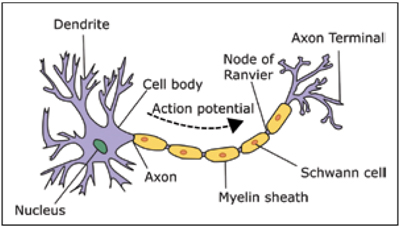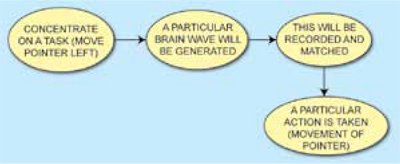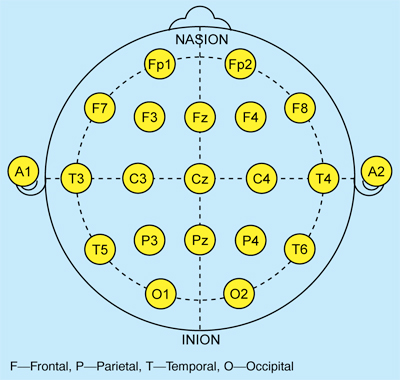The human brain is one of the most complex structures in the universe. Several experiments have been carried out to study it in a systematic and proper way. All these experiments have had their own limitations and unique results. It was Richard Caton who first studied the electrical activity of brains in rabbits and monkeys. Then, in 1924, Han Berger invented one of the most important machines of the 20th century—the EEG or the electro-encephalograph—which is used to graphically measure the brain’s waves. Now researchers have been able to make an interface between a computer and the brain, based on the latter’s electrical activity. Although earlier devices were very slow, now, due to the availability of high-speed electronics and efficient algorithms, various highly efficient BCI (brain computer interfaces) have been developed.


Future BCI will have the capability to change our perceptions of machines and create a very strong symbiotic relationship between humans and machines. Kevin Warwick, the first cyborg (cybernetic organism) and a British professor, has been successful in developing a unique bond between himself and his machines. Not stopping at this point, he has also developed telepathy chips that use RF signals and the signals from our nervous system. The BCI has been a boon for patients who are paralysed, giving them a chance to express themselves. Although BCI technology is advancing at a fast pace, its basic concept has remained the same since the early 1970s. In order to understand the concept of BCI, one must understand the electrical activity in the human brain.
The fundamental unit
Neurons are cells that have two ramifications: an axon and a dendrite (Fig. 1).
The axon of one neuron is in contact with the dendrite of the other by certain contact synapses. A neuron has thousands of synapses. Neurons can be polar, unipolar, bipolar, multi-polar, or pyramidal in nature, depending upon the dendrite structure. When the senses receive stimuli like sound, light or aroma, that information is coded and carried to the brain by neuron chains.
Neurons communicate through an electro-chemical process. When a signal reaches a synapse, it triggers the release of neurotransmitters, which are small molecules that diffuse in intercellular space, and this activates the receptors on other synapses. In turn, the activated receptor generates electrical signals of variable intensities. The signal coming from every synapse of a neuron passively converges to the base of its axon and then they are summed up. If the resulting signal is intense enough, the axon actively propagates the signal further; otherwise, it does not.
Thus, neurons use electricity to communicate with each other. Now imagine millions of neurons sending signals at the same time. This condition produces enormous amounts of electrical activity in the brain, commonly known as the brain-wave pattern because of its cyclic wave-like nature. These brain waves emit very small pulses of varied frequencies. Basically, we can divide brain waves into four categories: Delta, Theta, Alpha and Beta. Each category reflects a different state of a person’s mind.
According to Noroma solutions oy., these waves have the frequency range shown in the Table (on next page).

Besides, there are Lambda waves that represent visual attention, and Gamma waves in the range of 25-100 Hz. We also have Mu waves in the range of 8-13 Hz, found in the motor cortex, and their amplitude fluctuates based on physical movement or intent to move. Early BCI experiments, aimed at moving the cursors on a computer screen, exploited the Beta and Mu waves.
The BCI system
Overall, a BCI has four main components:
1. A signal capture system
2. A signal processing system
3. A pattern recognition system
4. A device control system
Let us look at the example of moving the mouse cursor. The signal capture system makes use of scalp electrodes (in older systems), together with a sticky gel, to obtain signal. As these electrodes capture the electrical activity (here, capturing means that some of the current passing through the axon escapes out), the signal passes through a unity gain amplifier to boost its level for processing. As these signals are impulses at discrete frequencies, we can use Fast Fourier transform algorithms to convert them to a discrete signal (basically an A/D operation). Then, in the machine or computer, DSP software is used for proper sequence generation, after which its output is fed to a pattern recognition system to select the proper pattern or symbol. In our case, it is the pointer; and then the control device produces the operation as per the signal processing and pattern recognition results. So, we have the sequence as shown in Fig. 2.
These brain waves or signals are generated due to the differences in electrical properties carried by ions on the membrane of each neuron. The problem is that the signals are mostly blocked while only a few escape—depending on our level of concentration. More concentration means more alertness (to the task), which increases the Beta waves that can be easily detected.
If a person has hearing problem in one ear, it could be because the sensor is damaged. But since the auditory nerves are operating, a device called the cochlear implant is inserted into the ear to process sound waves, converting them to electrical signals that are then passed via the auditory nerves.








